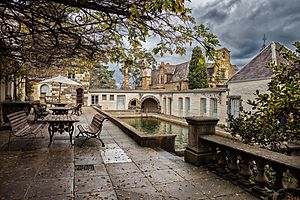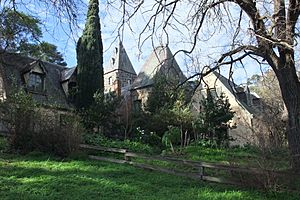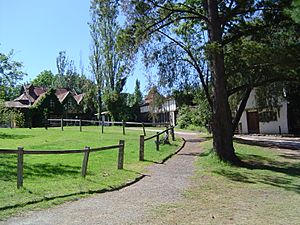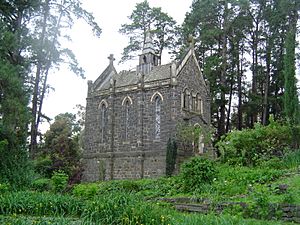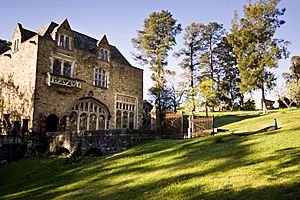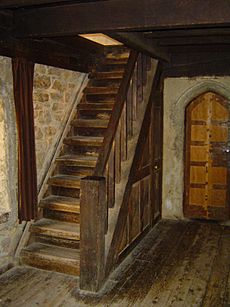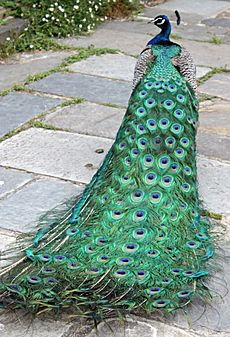Montsalvat facts for kids
Montsalvat is a special place for artists in Eltham, a suburb of Melbourne, Australia. It was started by Justus Jorgensen in 1934. This unique colony is built on five hectares (about 12 acres) of land with beautiful gardens. You'll find many different buildings here, like houses, halls, studios, galleries, and even stables.
All the buildings at Montsalvat were designed and built by the artists and people who lived there. They used materials from many places, including old buildings being taken down in Melbourne city. Today, Montsalvat's grounds and buildings are used for art shows, music performances, meetings, and even weddings. Artists still live and work here, and they offer art classes all year round.
Montsalvat is a popular place for tourists to visit. The whole area is listed on the Victorian Heritage Register, which means it's an important historical site.
Contents
What Does Montsalvat Mean?
The name Montsalvat comes from old stories and myths. In a German opera called Parsifal by Richard Wagner, Montsalvat is a magical castle where a special item called the Holy Grail is kept safe. In another opera, Lohengrin, it's also mentioned as a special home.
In the English legends of "King Arthur and the Knights of the Round Table", Montsalvat is also known as the home of the Holy Grail. Even though Montsalvat in Australia only started in 1934, it has created its own interesting stories. The name "Montsalvat" actually means "Saved Mount" in the Catalan language.
History of Montsalvat
How Montsalvat Began
Montsalvat was the idea of Justus Jorgensen, and many people helped him build it. Jorgensen was born in 1894. He first trained to be an architect in Melbourne. Later, he decided to become a painter and studied at the National Gallery School of Art. He learned a painting style called tonalism from an artist named Max Meldrum.
In 1924, Jorgensen married Lillian Smith. That same year, they traveled to Europe with artist friends. They painted in places like Italy, Spain, France, and England. They also visited famous art galleries to study old and new European paintings. Jorgensen even had his own art studio in Paris.
He came back to Australia in 1929. During his time in Europe, Jorgensen was quite successful. His paintings were shown in important galleries in Paris and London. You can see the influence of Europe in both his paintings and the buildings at Montsalvat. He bought a home in Brighton, Melbourne, and later had a city studio in Queen Street where he taught art.
In 1934, while Jorgensen was designing a studio in Eltham for another artist, he decided that Eltham was where he wanted to live. This is how the dream of Montsalvat started. Jorgensen invited his students and friends to join him in Eltham. Together, they began building Montsalvat.
Many early students and friends helped, including writer Mervyn Skipper and his family. Other artists like Helen Lempriere and John Busst were also involved. Even famous Australian artists like Leonard French and Albert Tucker were connected to Montsalvat.
Building the Colony
The Eltham area had been settled since the 1850s. Some early settlers used mud bricks to build their homes, but this method was no longer common. Jorgensen saw how useful this building technique could be. The local soil was good for making mudbricks and rammed earth, and it was cheap. So, he had his students learn how to do it.
They found materials from many different places. Slate for roofs came from a friend's old house that was being taken down. Discarded bricks, tiles, and other items came from other building sites. The old Bijou Theatre in Melbourne, which was being demolished, was a great source. It provided a beautiful cast iron spiral staircase, fancy door frames, and some doors and windows. Helen Lempriere's family even gave money and materials to build the pretty pond.
The Great Hall
Work on the Great Hall started in 1938. Jorgensen first planned a smaller building made of mud brick. But during digging, they found a layer of special stone called mudstone. The unique colors of this stone inspired Jorgensen to change his plans and build a much larger Great Hall. He was lucky because the Royal Insurance Building in Melbourne was being demolished. This building had beautiful limestone windows and stone balconies with Gothic carvings. These now decorate the Great Hall and make it look very special. Students also carved other windows and funny gargoyles.
More stone for the walls came from a nearby quarry. Other stones like bluestone, granite, and limestone came from other demolition sites around Melbourne. Some of the floor stones and roof slates were even brought from Ireland and Wales long ago as ballast on ships.
Building the Great Hall stopped when World War II began. Some students joined the army, while others helped at home. Montsalvat became a farm and market garden. Jorgensen and his smaller team used their creativity to build barns and sheds for the farm. Materials were hard to find, but they used whatever they could, like broken bricks, rusty metal, and timber from the bush. They also had a dairy and poultry farm, selling their produce at local markets.
After the war, work on the Great Hall and other buildings started again. The slate floor in the hall and the wooden floors above were finally put in. Students carved decorative pieces around the windows and doors as part of their art training. Some stonework came from Wilson Hall at the University of Melbourne, which was damaged by fire. Many local workers, new students, and artists joined the team.
Montsalvat Today
In 1975, Montsalvat became a Charitable Trust, which helps manage it for the public good. Jorgensen's youngest son, Sigmund, became the chairman. In 1989, the Victorian Government recognized Montsalvat's importance by adding it to the Heritage Victoria's Register. Later, it was also listed on the Australian Register of National Estate.
In 1996, a red brick barn near the entrance was burned down. It was rebuilt and is now the main entrance and exhibition space called the Barn Gallery. Most art shows and performances are held here today.
Montsalvat today is a place where new and experienced artists can show their work. Tourists from all over the world enjoy visiting its unique buildings and gardens. You can find Montsalvat listed in many Melbourne tourist guides. Public events, art exhibitions, and performances happen often. The Great Hall, Long Gallery, Barn Gallery, and Chapel are used for private events like weddings and parties. Montsalvat also has spaces for business meetings and conferences, which can hold up to 200 people.
Montsalvat in Movies and TV
Montsalvat has been used as a filming location for several movies and TV shows:
- It was used for two vampire films: Thirst (1979) and Queen of the Damned (2002).
- It appeared in the opening scenes of the Australian film Felicity (1979).
- In the TV show Neighbours, it was used as an abandoned monastery in 1985. In 2008, it pretended to be Portugal, and it was also the location for a wedding scene.
- It was featured in an episode of Miss Fisher's Murder Mysteries called "Murder under the Mistletoe" in 2013.
- Scenes for a wedding in Season 6 of the Australian drama Offspring were filmed here in 2016.
- Scenes for the film Judy and Punch, set in 17th century Britain, were filmed here for its 2019 release.


